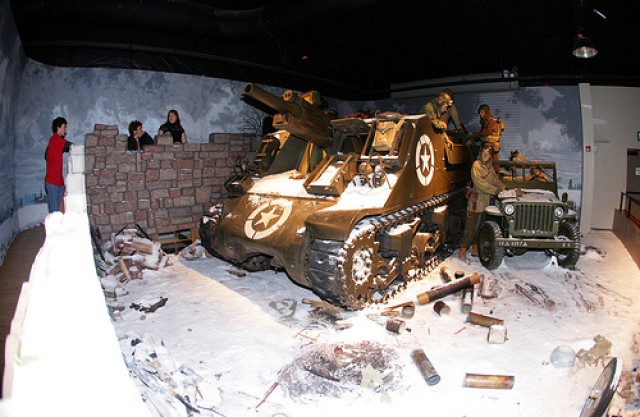FORT SILL, Okla.--You expect World War II veterans to be affected by a Battle of the Bulge display at the Field Artillery Museum, but wouldn't expect much of an emotional reaction from a Soldier fresh from today's battlefield.
That situation developed as one volunteer got a morale boost as he worked beside other volunteers on the new diorama.
Staff Sgt. Dustin Roderigas is recovering in the Warrior Transition Unit from wounds he suffered in combat, and for this Soldier working at the museum was more than just a job.
"I've learned a lot about myself - when I was wounded I felt there was a lot I couldn't do," Roderigas said. "But, Mr. [Gordon] Blaker gave me this opportunity, and it helped me discover I can do a lot of things and it jump kicked some things I was having problems with."
While he heals and awaits the results of his medical evaluation board, Roderigas gets to employ his lifelong love of military history.
"This work helps me take care of myself and get better, but at the same time I'm helping preserve history and bringing it alive through displays like this new diorama," he said. "I enjoy putting something together that's historically accurate, that the public can view and get a feel for what things actually looked like in 1944."
Coming from a family of veterans, Roderigas said his earliest memories are of wanting to be a Soldier. He has his own collection of vintage Army gear, some of which he's donated to the museum. One item he didn't donate was the 1944 Army jeep he restored in 2001.
That vehicle and his knowledge of authentic accessories gave him the experienced eye to recognize inconsistencies with the museum's jeep. "The jeep had 1950s and 60s parts on it that had to be replaced," he said. "Thirty-eight parts later, we got it back to its wartime condition."
With a new coat of paint, he had the jeep looking ready for duty again, except for one small detail...military vehicles usually sport a name.
Blaker allowed Roderigas to name the jeep. Now, "Claire Ann" graces the frame above the driver's left rear wheel. No, this isn't some glamorous pinup girl common on other vintage vehicles. Roderigas named the vehicle for his 18-month old.
Gordon Blaker, museum curator, the staff and volunteers built the diorama around the hulking mass of a nearly immobile 25-ton M-7 Priest self-propelled howitzer. The diorama depicts a crew firing the howitzer from behind the crumbling walls of a Belgian farmhouse during the battle which began Dec. 16, 1944 amid heavy snow and poor weather conditions. In the foreground, a jeep carrying the B Battery commander for the 420th Armored Field Artillery Battalion arrives with a resupply of ammunition and instructions for the next fire mission.
Exhibit construction began with Directorate of Logistics forklift drivers lifting the gun, carrying it into the museum and pushing it until it would no longer budge - it's current location.
Volunteers Ray Rowland and Claude Matchette then assaulted 50 years of accumulated rust and dirt. Blaker said the men stripped nearly 500 pounds of debris from the vehicle then scrubbed off the oxidized paint in almost 15 days of work. Harry Shappell, another volunteer, fabricated many of the missing metal pieces to return the gun to a fighting-ready appearance.
The Priest was so named because of the rounded pulpit-like machine gun ring adjacent to the gun barrel.
After building a sloping boardwalk behind the diorama to let visitors look inside the gun, mannequins were outfitted with period uniforms. Blaker said the mix of uniforms lets visitors see the different types of uniforms Soldiers wore during World War II. He said this look was entirely authentic.
"It was not all neat and spiffy; many of those Soldiers spent days, weeks and months at a time in combat," Blaker said.
Professional artists, armed with photos of the Belgian countryside in winter, completed the effect painting the surrounding walls to replicate the environment in which the battle took place.
The team finally added simulated snow, mud and other battlefield debris -- such as a German SS field cap, a Luftwaffe paratrooper's helmet and the paratrooper's recoilless rifle, which suggests that a German unit recently occupied the site.
"Because self-propelled guns were a big part of artillery since World War II, I believed it was important to get the M-7 Priest in here," said Blaker.
As Blaker looked over the diorama, he said the results far exceeded his expectations.
"I never did a snow scene before and knew this would be difficult, but it would be the most interesting as it would give people an impression of just how miserable the battlefield conditions were," he said.
"It even makes me feel cold."


Social Sharing